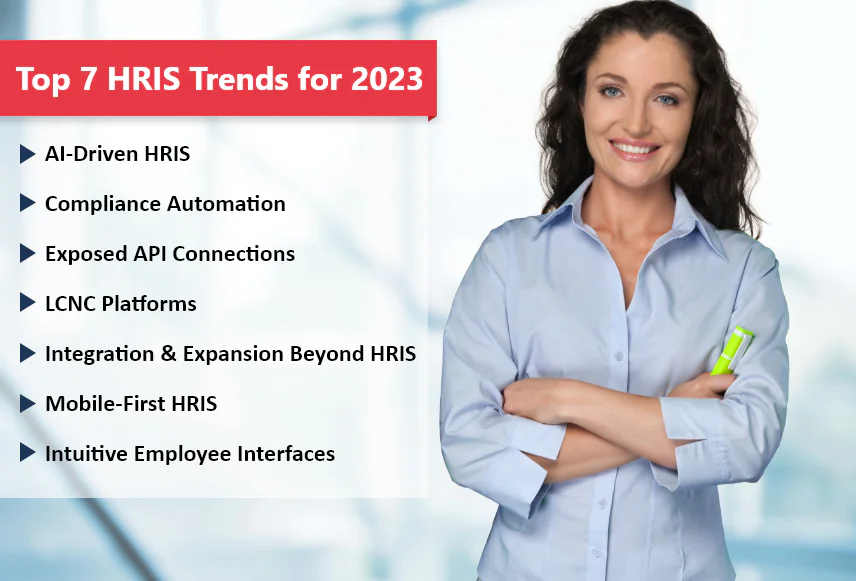
Are you keeping track of the HRIS trends 2023? Do you have a complete understanding of these trends? If not, this excellent compilation of the HRIS trends 2023will help you achieve these goals. It is essential for organizations to empower their HR to expand their capabilities and do more with less. Afterall, HR does play a critical role for organizations to stay ahead of the curve while gaining executive and business successes.
As the workforce evolves with remote work and globalization, HR management is undergoing a drastic transformation. We now live in a world where virtual meetings and remote collaboration have become the norm. In such an environment, HR leaders must be equipped with the right HR software, tools, and knowledge to maintain employee harmony.
Learning about the latest Human Resource Information System (HRIS) trends 2023 enables HR to make informed decisions and harness the full potential of technology to drive HR and organizational success. It’s about adapting to the ever-changing landscape and leveraging emerging trends to improve employee experience, foster collaboration, and optimize HR operations.
Before diving into the ocean of HRIS trends 2023, let’s take a step back and understand HRIS and its role in supporting effective HR management.
By leveraging HRIS, organizations can streamline HR processes, enhance HR efficiency, and help HR make data-driven decisions. Stay informed about the latest HRIS trends 2023 to take your HR team to the next level and help your organization advance in the competition. Get ready to navigate the exciting possibilities that lie ahead!
Basics of HRIS
HRIS is a software or platform that integrates and centralizes various HR processes and data, streamlining HR operations within an organization. It also helps HR automate routine tasks and improve data accuracy.
HRIS typically includes features such as employee data management, payroll, benefits administration, time and attendance tracking, recruitment, performance management, and reporting.
Benefits of Using HRIS
Here are some key benefits of deploying HRIS in your organization.
1. Streamlined Processes
HRIS centralizes HR functions, automates tasks, and eliminates manual record-keeping, resulting in streamlined operations and increased efficiency.
2. Accurate Data and Reporting
HRIS ensures data integrity, minimizes errors, and provides reliable information for generating comprehensive reports and analytics, facilitating informed decision-making and compliance management.
3. Employee Self-Service
HRIS includes self-service portals that allow employees to update their information, request time off, access pay stubs, and participate in performance reviews, improving the employee experience and reducing administrative workload.

Top 7 HRIS Trends 2023 to Keep an Eye On
Let’s unveil the seven must-know HRIS trends 2023 that will revolutionize the way organizations manage HR. Get ready to unlock the future of HRTech and gain a competitive edge in the current fast-paced business world ruled by technology.
1. Implementing AI-Driven HRIS
AI is certainly one of the best HRIS trends 2023 so far! As observed, AI is increasingly integrated into HRIS. In 2023, expect HRIS to leverage AI for enhanced data analysis, predictive analytics, and automation of routine HR tasks. AI algorithms can help identify patterns in employee data, predict attrition risks, and recommend personalized learning and development opportunities.
For instance, AI is particularly valuable in recruitment due to its impartiality, rapid processing capabilities, and ability to assist hiring teams promptly. HRIS and ATS solutions already aid in resume parsing, but AI can take this function a step further by identifying patterns found in the resumes of high-performing employees.
Have you enabled OpenAI GPT and NLP-based automation for recruitment? Learn how Harbinger simplified and streamlined hiring with GPT API and NLP for a global technology company.
Additionally, AI can access calendars and assist in interview scheduling. By autonomously managing interview scheduling, AI expedites communication with candidates, saves the time of hiring staff, and minimizes scheduling conflicts.
2. Streamlining Compliance through Automated Features
Compliance with various regulations is paramount for businesses, particularly in employer-employee relations. Meeting the documentation requirements imposed by local, state, and national authorities throughout an individual’s employment journey can be daunting for HR teams. This is especially true as the regulations evolve and the organization expands constantly.
Many HRIS solutions are embracing automation to simplify compliance processes and ensure effortless updates of information, policies, and procedures for employers and employees to alleviate the burden.
These automated compliance features include:
i. Scheduled automation of compliance procedures
HRIS automates the scheduling of compliance-related tasks, sending alerts to designated administrative personnel before deadlines for upgrades and audits.
ii. Automated reminders and instructions for employees
HRIS sends automated reminders and instructions to new hires and existing employees, prompting them to review and update their personally identifiable information.
iii. Integrated self-service support
HRIS provides employees with self-service resources to address compliance-related concerns. This includes access to compliance training modules, frequently asked questions, and knowledge base platform for HR and compliance queries.
3. Using Exposed API Connections
The availability of APIs for integrations is one of the HRIS trends 2023 that has increased the pace of software development many folds. Several portals make their functionality available for use through APIs. Low coding platforms like Salesforce also provide seamless integration with an underlying platform and other applications available on the platform using exposed APIs.
Another popular development trend is building connectors using exposed APIs so that any two applications in the HRIS domain (for example, a recruiting platform and background check software) can exchange information seamlessly.

4. Deploying Low-Code/No-Code (LCNC) Platforms
While LCNC tools have gathered significant attention in the aftermath of the COVID-19 outbreak, they existed long before the pandemic began. More organizations are delving into LCNC development,
allowing professionals outside of IT to design and develop solutions to problems relevant to their function.
Organizations can help HR save a lot of development time and expenses by developing its software using the LCNC approach. LCNC platforms can enable HR to replace cumbersome spreadsheets with more efficient workflows, develop surveys, create talent analytics dashboards, and reduce manual tasks.
Harbinger integrated high-volume hourly hiring platform with ADP using Workato ready-to-use connectors. Learn how the LCNC enablement through Workato aided in faster development and no separate or additional deployment.
5. Embracing Integration and Expansion Beyond HRIS
Traditionally, organizations have operated HRIS independently, separated from other company software. This separation stemmed from the belief that employee analytics had a limited direct impact on revenue or business intelligence.
However, businesses are now recognizing the flawed nature of this belief. They realize that data metrics such as the performance of critical hires and comparing tenured and newer staff directly influence an organization’s key performance indicators and future business intelligence for effective planning.
The understanding that employee data can provide valuable insights into other aspects of the business has sparked a greater emphasis on seamless integration between HRIS and other business software. Furthermore, many users are now moving beyond the limitations of traditional HRIS platforms and seeking tools that offer more comprehensive payroll and business intelligence capabilities internally.
While HR software remains a vital component of business technology, organizations realize that the latest HRIS trends 2023, such as integration and expansion, provide the means to fully incorporate HR data into the broader infrastructure of the entire company.
Want to know how to expedite scalable HR integration and automation delivery?

6. Adopting Mobile-First HRIS
In 2023, HRIS providers will prioritize mobile-first designs, considering the increasing reliance on mobile devices. Employees and HR can access HRIS features anytime and anywhere, with mobile-responsive interfaces and dedicated apps. This mobile HRIS approach enables seamless, on-the-go tasks like time tracking, document signing, and performance reviews.
Liberating users from desk-bound limitations, mobile HRIS solutions provide a convenient and efficient employee experience that aligns with today’s fast-paced work environment.
Whether traveling, working remotely, or simply preferring portable convenience, the true power of HR management can be at your fingertips through HRIS. Prepare for a new level of productivity and flexibility as HRIS embarks on this mobile-centric journey.
7. Developing Intuitive and Accessible Employee Interfaces
HRIS solutions are undergoing a significant shift in their approach to user experience by prioritizing the creation of user-friendly and intuitive dashboards. Gone are the days of lengthy employee handbooks and mandatory onboarding sessions. Instead, onboarding processes are seamlessly integrated into HRIS, where assignments, administration, and tracking occur.
One of the most prominent HRIS trends 2023that continues to gain momentum is the focus on designing dashboards that cater to all users, regardless of their role within the organization. While traditional HRIS often emphasizes elaborate design and many HR modules, the current emphasis lies in developing simpler, more navigable designs that are compatible with mobile and desktop platforms.
Here’s everything you need to know about HRTech trends 2023. We interviewed industry experts to get their insights on the top HRTech trends for 2023 and the future of HR.
Make HRIS Your Ally: Embrace the HRIS Trends 2023
Whether they are upgrading existing HRIS or seeking new HRIS solutions that align with evolving HR and organizational needs, large and small organizations alike need to be aware of and understand the latest HRIS trends 2023.
The HRIS landscape is poised for remarkable transformation, with several compelling trends on the horizon. From integrating AI for improved recruitment process to focusing on user-friendly dashboards that foster employee engagement, the future of HRIS is about leveraging technology to empower HR professionals and employees.
As organizations navigate the evolution of HRIS, staying informed about these HRIS trends 2023 will help them optimize HR operations, drive employee satisfaction, and push their business toward success. By embracing these HRIS trends 2023, you can make HRIS solutions your invaluable ally in shaping the future of HR and fostering a thriving, connected, and agile workforce.
Are you ready to take charge of the future of HR and ensure your organization stays ahead of the curve? Look no further – we’re here to provide the helping hand you need. Don’t let the rapid changes in technology overwhelm you. Share your HRTech needs with our experts at contact@harbingergroup.com.






